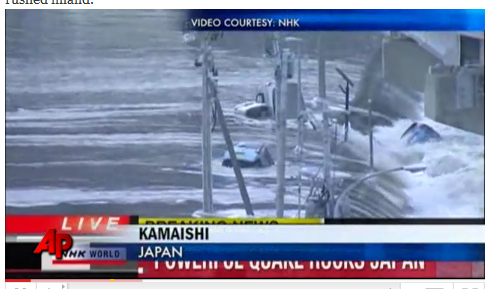Why Do Some Earthquakes Cause Tsunamis But Others Don't?

A devastating 8.9-magnitude earthquake rocked the east coast of Honshu, Japan, early Friday morning, triggering a 30-foot-high tsunami that has caused the U.S. National Weather Service to issue a warning for at least 50 countries or territories around the Pacific. The tsunami waves have already reached Hawaii, where officials have ordered an evacuation of Hawaii's coastal areas.
Why do some earthquakes cause tsunamis while others don't?
A few factors come into play: the strength of the quake, the direction of the temblor's motion and the topography of the seafloor. [Japan Earthquake & Tsunami of 2011: Facts and Information]
First, magnitude of the quake, which is a measure of the amplitude of the largest seismic wave recorded for the earthquake, must exceed a certain threshold. The 8.9-magnitude of Japan's earthquake was enough to trigger a tsunami, but the magnitude-7.7 earthquake that struck Indonesia in October 2010 just surpassed the threshold for causing a tsunami. (Magnitudes are measured on a logarithmic scale, so a magnitude-5 temblor would have seismic waves that are 10 times greater in amplitude than a magnitude-4 earthquake.)
"Earthquakes below 7.5 or 7.0 usually do not trigger tsunamis," said geophysicist Don Blakeman of the U.S. Geological Survey's National Earthquake Information Center. "However, sometimes 6.0 earthquakes can trigger local tsunamis, which are smaller and less destructive."
The earthquake that struck Haiti in January 2010 actually triggered a set of small, local tsunamis, recent research found. But because the earthquake's aftershocks did not exceed magnitude 5.3, they were not big enough to cause additional tsunamis, according to USGS spokesman Bob Kimmel.
Earthquakes trigger tsunamis when the seismic activity causes the land along fault lines to move up or down. When parts of the seafloor shift vertically, either becoming raised or lowered, entire water columns become displaced. This creates a "wave" of energy, which propels the water, according to Blakeman.
Sign up for the Live Science daily newsletter now
Get the world’s most fascinating discoveries delivered straight to your inbox.
Earthquakes that push land mainly in the horizontal direction are less likely to cause the devastating waves, according to USGS geophysicist John Bellini. When energy pushes the plates horizontally, the land does not raise or lower the water above it enough to cause a tsunami, Bellini said.
The height of a tsunami wave is influenced by the ground's vertical movement, so changes in the seafloor's topography can either amplify or dampen a wave as it travels along.
"When moving in the ocean, a tsunami wave typically travels at up to 500 or 600 miles an hour – roughly the speed of a jet," Blakeman said. "But it slows down as it approaches land."
"Water suddenly and drastically receding from shore is a warning sign of an approaching tsunami," Blakeman told Life's Little Mysteries.
Tsunamis sometimes come in pairs. A 7.7-magnitude earthquake that struck Indonesia in April triggered two tsunamis, according to the Indonesian Meteorological and Geophysics Agency.
One thing that doesn't affect tsunamis is the weather. Because they are powered by energy from ocean-floor shifting, the waves aren't significantly impacted by surrounding weather conditions, Blakeman said.
To determine whether an earthquake will generate a tsunami, and to predict how severe it will be, researchers measure the height and energy of the ensuing wave by using ocean-pressure sensors and tide gauges, according to the USGS.
Originally published on Live Science.









